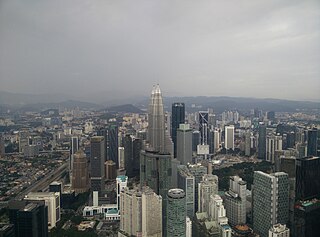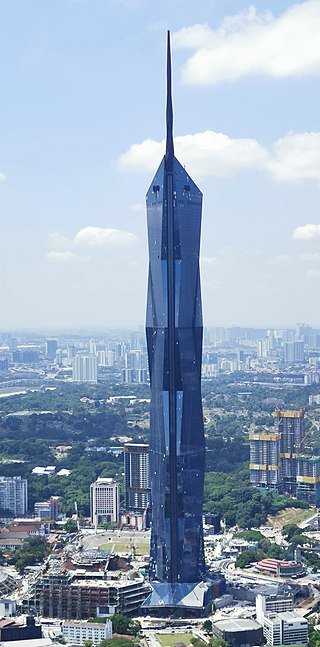Related Research Articles

Kuala Lumpur, officially the Federal Territory of Kuala Lumpur and colloquially referred to as KL, is a federal territory and the ceremonial, legislative and judicial capital city of Malaysia. It is one of the fastest growing cities in Asia and the largest city in Malaysia, covering an area of 243 km2 (94 sq mi) with a census population of 1,982,112 as of 2020. Greater Kuala Lumpur, also known as the Klang Valley, is an urban agglomeration of 7.564 million people as of 2018. It is among the fastest growing metropolitan regions in Southeast Asia, both in population and economic development.

Kuala Lumpur Sentral Station is a transit-oriented development that houses the main railway station of Kuala Lumpur, the capital of Malaysia. Opened on 16 April 2001, KL Sentral replaced the old Kuala Lumpur railway station as the city's main intercity railway station. KL Sentral is the largest railway station in Malaysia, and the second largest in Southeast Asia, behind Krung Thep Aphiwat Central Terminal in Bangkok, Thailand.

UEP Subang Jaya is a major affluent township located in Subang Jaya, Selangor, Malaysia. It is located within the Mukim (sub-district) of Damansara in the district of Petaling.


Rapid KL is a public transportation system owned by Prasarana Malaysia and operated by its subsidiaries Rapid Rail and Rapid Bus. With its coverage throughout Kuala Lumpur and Klang Valley areas, it was followed by a federal government restructuring of public transport systems in Kuala Lumpur after the bankruptcy of STAR and PUTRA Light Rapid Transit operators, the precursors to the Ampang/Sri Petaling Lines and Kelana Jaya Line respectively. In 2003, it had inherited bus services and assets formerly operated and owned by Intrakota and Cityliner after being bailed out. Four years later, the Malaysian government had bailed out KL Infrastructure Group, the owner and operation concession holder for the Kuala Lumpur monorail, and had placed it under ownership of Prasarana.

Ampang, or Ampang Hilir, is a ward and city district, in the eastern part of Kuala Lumpur (KL) in the Titiwangsa constituency. Its area in Kuala Lumpur can be identified as being along the Ampang Road and Ampang Hilir.

Kuala Lumpur City Centre (KLCC) is a multipurpose development area in Kuala Lumpur, Malaysia. KLCC refers to the area within and surrounding the KLCC Park but the term has also been widely used by buildings nearby to the vicinity.


Ampang Park Shopping Centre was a shopping centre located on Jalan Ampang in Kuala Lumpur, also was called as Ampang Park. It was the first shopping centre to be built in Malaysia. It is designed by the architect of Singapore's People's Park Complex, the Design Partnership, in conjunction with Kuala Lumpur-based architect Thomas A.S. Tiang. The developers were the Low Keng Huat Brothers Realty Sdn Bhd. Ampang Park was closed on 31 December 2017 and demolished in 2018 to make way for the construction of MRT Ampang Park Station which opened on 16 March 2023. Further redevelopment of the former site is yet to begun and the site currently serve as a temporary recreational park along with connecting walkway path to Ampang Park LRT Station.

Bukit Jalil LRT station is an LRT station in Bukit Jalil, Kuala Lumpur, Malaysia.

Ampang Park station is a metro station in Kuala Lumpur that is served by RapidKL's LRT Kelana Jaya Line and the newly-constructed MRT Putrajaya Line. The LRT station is the last underground station on the Kelana Jaya Line along Jalan Ampang, near the Jalan Tun Razak intersection. before the line heads above ground again at Damai LRT station, while the MRT station is situated on the former site of Ampang Park Shopping Centre as one of the three Putrajaya Line stations around KLCC.
Rapid Rail Sdn Bhd is the operator of the rapid transit (metro) system serving Kuala Lumpur and the Klang Valley area in Malaysia. A subsidiary of Prasarana Malaysia, it is the sole operator of five rapid transit lines which collectively form the Rapid KL rapid transit system. The system currently consists of three light rapid transit (LRT) lines, two mass rapid transit (MRT) lines and a monorail line, with another MRT and LRT line currently under construction.

The LRT Ampang Line and the LRT Sri Petaling Line are medium-capacity light rapid transit (LRT) lines in the Klang Valley, Malaysia. The combined network comprises 45.1 kilometres (28.0 mi) of tracks with 36 stations and was the first railway in Malaysia to use standard-gauge track and semi-automated trains. It is operated as part of the RapidKL system by Rapid Rail, a subsidiary of Prasarana Malaysia.

Arthur Oakley Coltman was an English architect practising in Malaya for 32 years where he worked as manager of the architecture firm Booty Edwards & Partners. He arrived in Malaya in 1925 and retired in 1957.
BEP Akitek Sdn Bhd is an architectural firm based in Malaysia. Ralph Booty & Sidney James set up their practice in Singapore in 1910 and began the Booty Edwards & Partners firm on September 7, 1923. Ralph Booty had previously operated the firm Ralph Booty and Co. The new firm was first called Booty and Edwards.Arthur Oakley Coltman bought the firm in 1930. It was later called Booty, Edwards & Partners and the firm operated with offices in Colombo, Penang as well as Kuala Lumpur. In 1969 the firm was renamed BEP Akitek Sdn Bhd, the name it still carries. A major event in the firm's early history is when it won an architectural competition for the design of Colombo’s Town Hall and Municipal Offices, held in 1922. The Town Hall remains an imposing landmark in Colombo city. On May 24, 1924, the foundation stone was laid to build this magnificent building to house the Municipal Council of the country's principal city.


Bukit Bintang City Centre, also known as BBCC for short, is a 19.4 acres (7.9 ha) mixed-use development on the former site of Pudu Prison in Kuala Lumpur, Malaysia. The development is located at the south western end of Bukit Bintang, bordering with the Pudu district along Jalan Hang Tuah and Jalan Pudu.
References
- ↑ "Ampang Park Advertisement". The Straits Times. 5 September 1971. Retrieved 7 December 2014.
- ↑ "Ampang Park Shopping Centre". Vision KL. Vision KL. Retrieved 7 December 2014.
- ↑ "Ampang Park relives its glorious past". The Star Online. The Star. 27 March 2013. Retrieved 7 December 2014.
- ↑ "Ampang Park Shopping Centre Website". Ampang Park. Retrieved 7 December 2014.
- ↑ "Ampang Park Shopping Centre". The Straits Times. 5 September 1971. p. 20.
- ↑ "Ampang Park". The Straits Times. 5 September 1971. p. 20.
- ↑ "Ampang Park Shopping Centre". Information Directory Malaysia Central. Retrieved 7 December 2014.
- 1 2 "Arkitek AAP Company Profile" (PDF). Arkitek AAP. Arkitek AAP. Retrieved 7 December 2014.